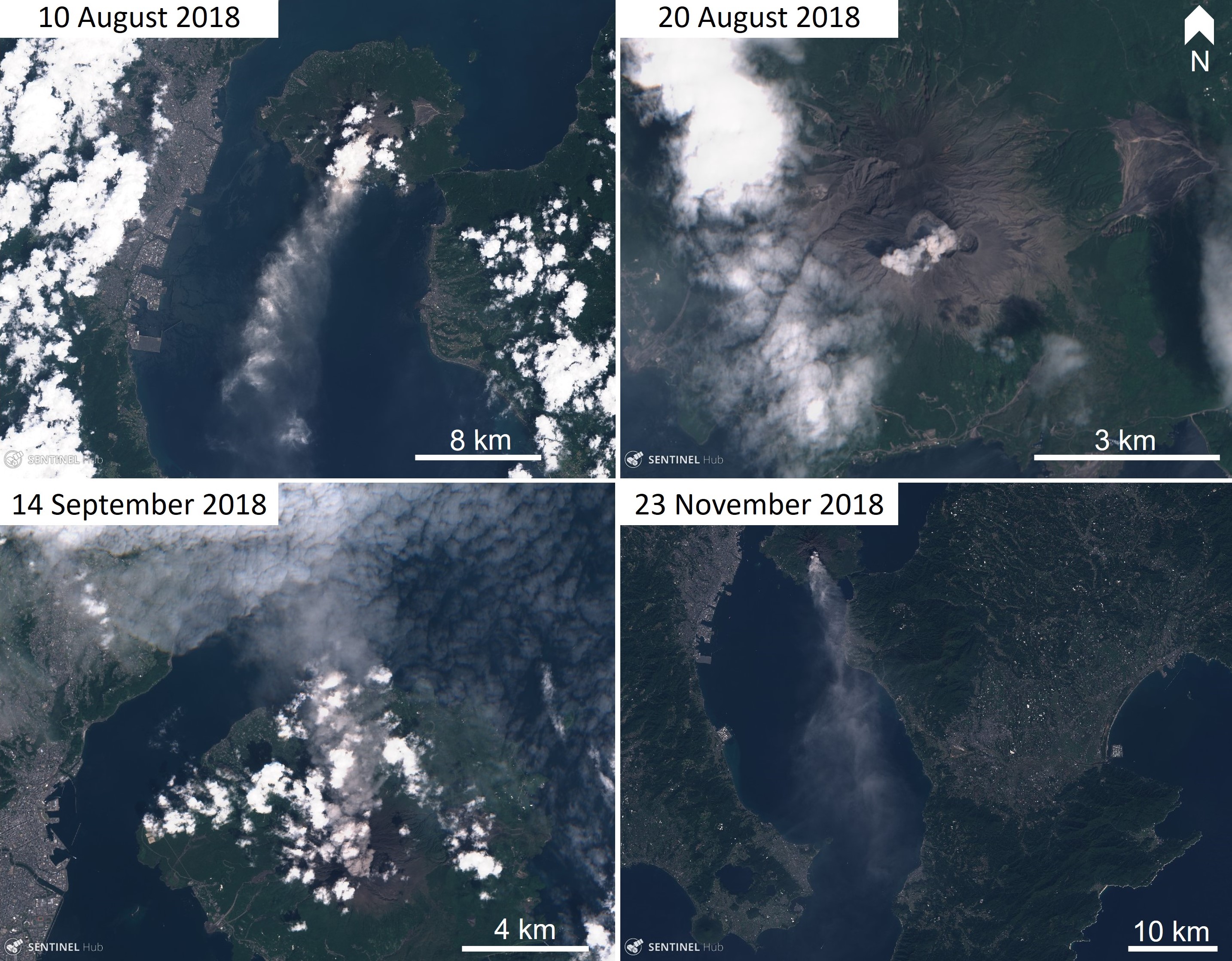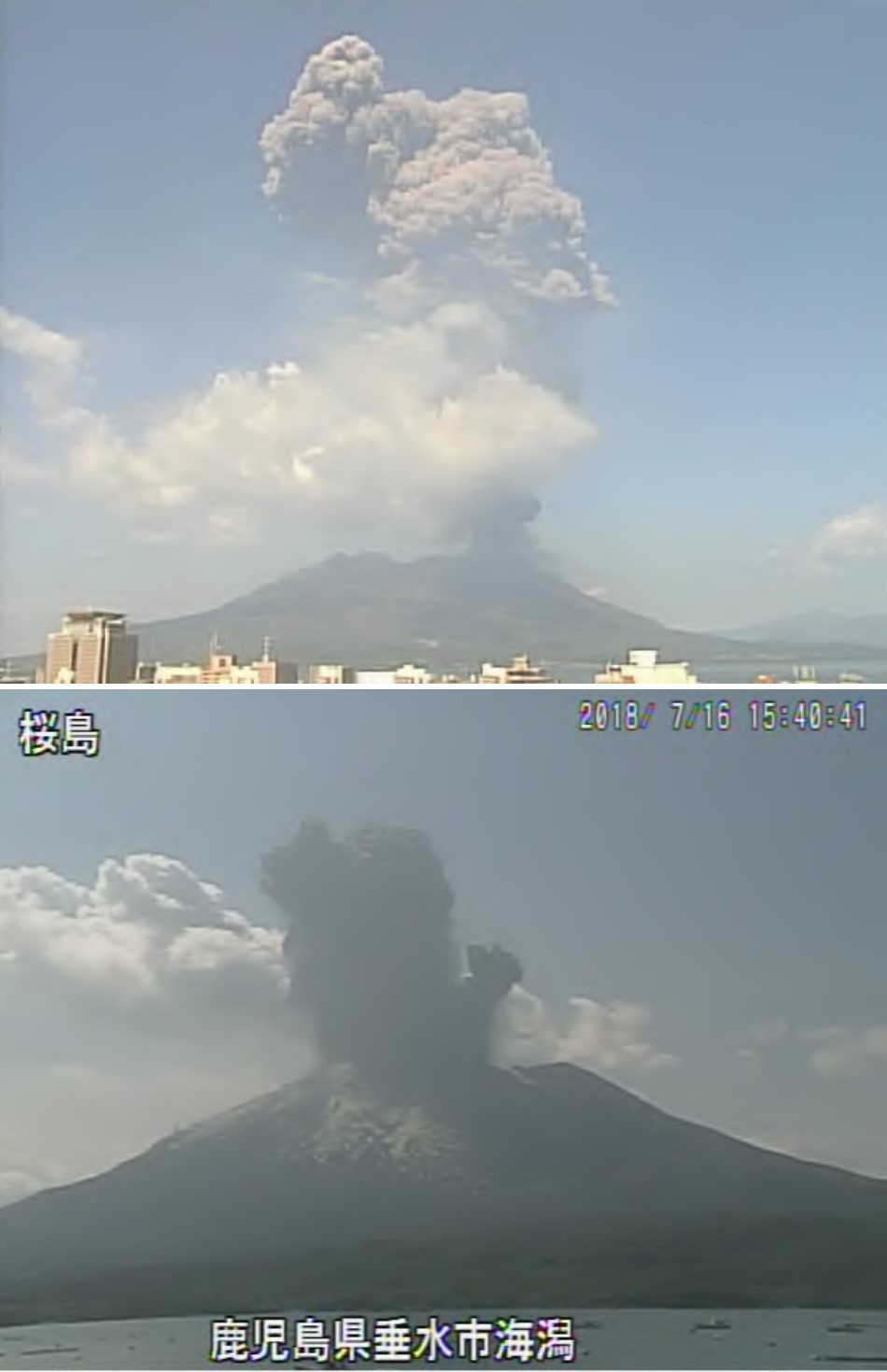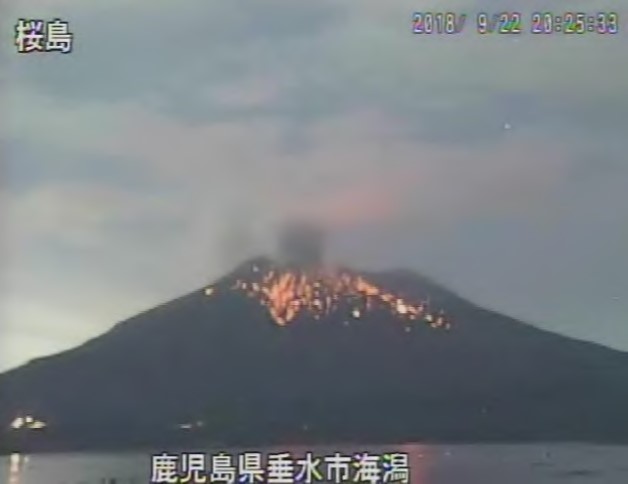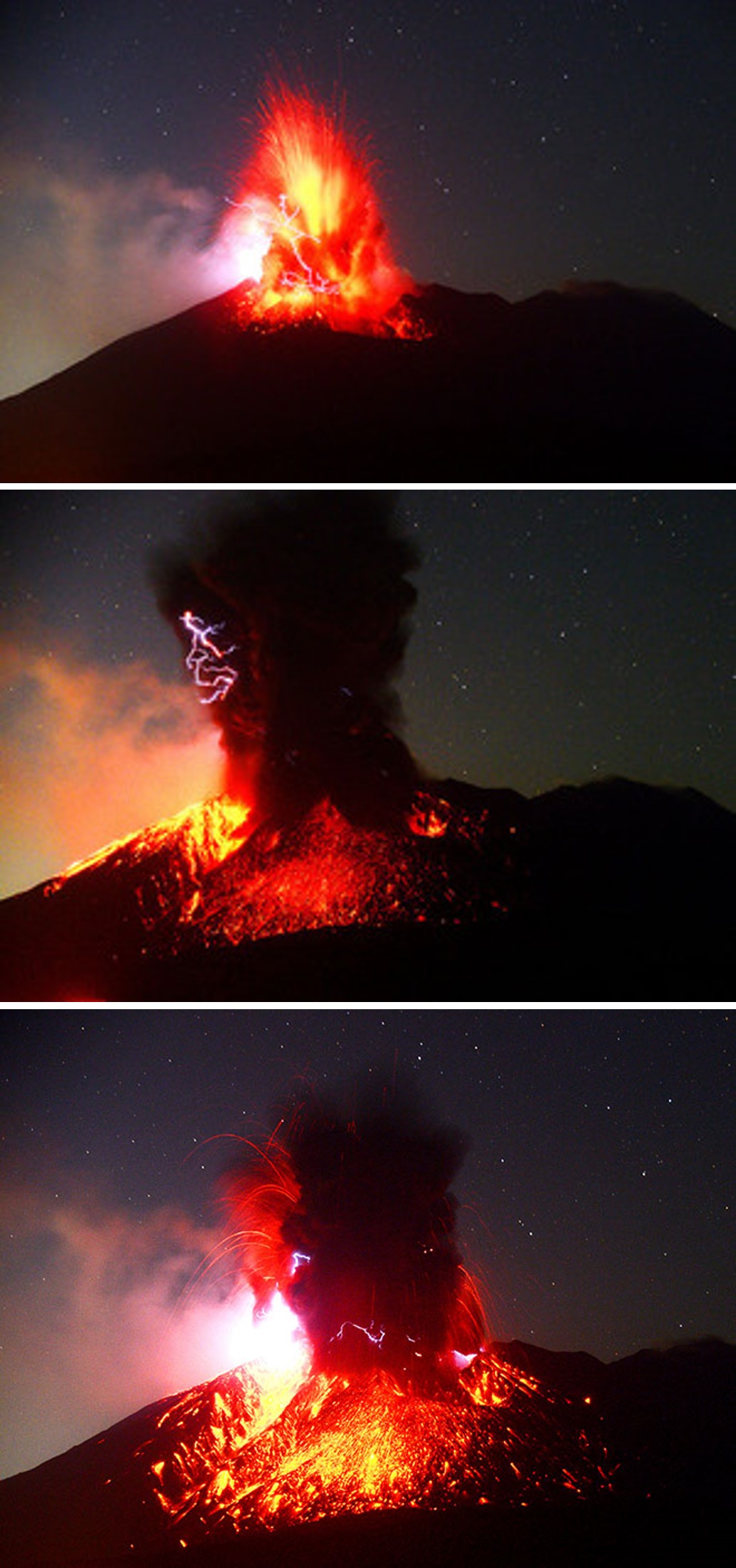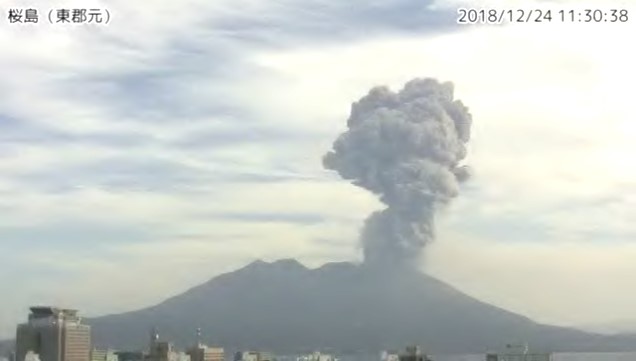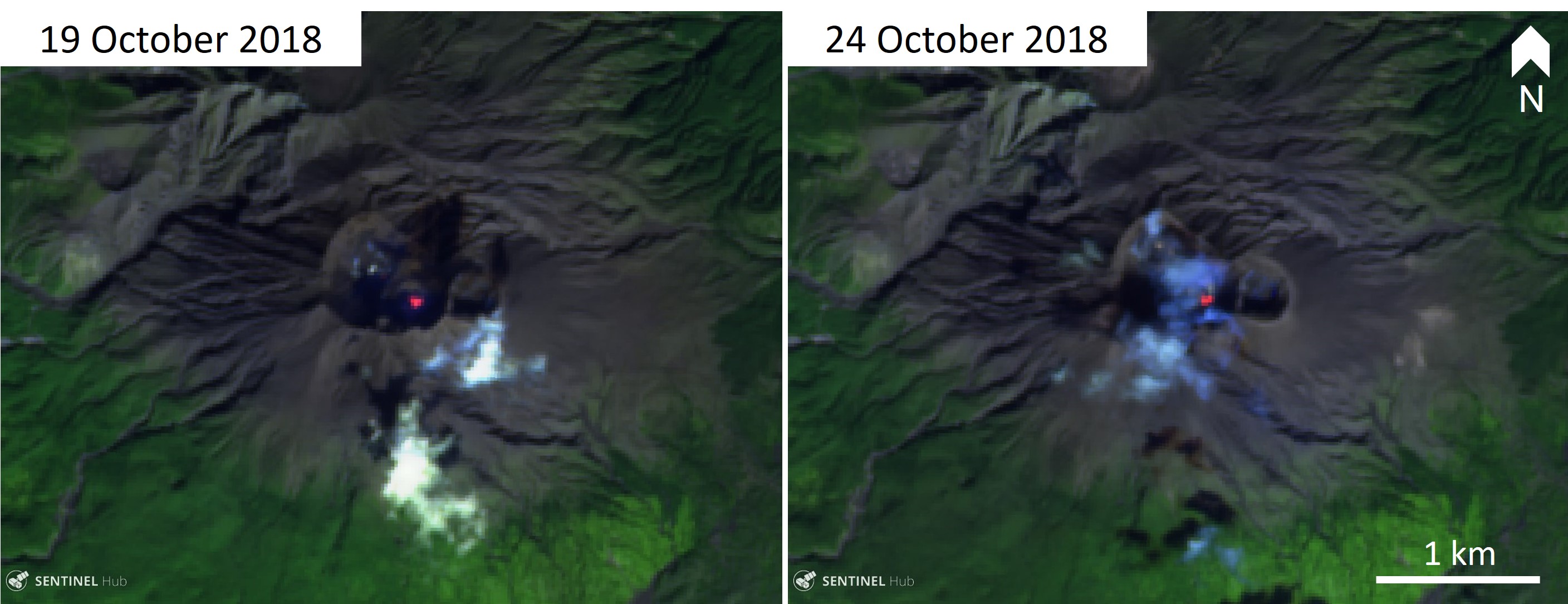Report on Aira (Japan) — January 2019
Bulletin of the Global Volcanism Network, vol. 44, no. 1 (January 2019)
Managing Editor: Edward Venzke.
Edited by Janine B. Krippner.
Aira (Japan) Ash plumes continue at the Minamidake crater from July through December 2018
Please cite this report as:
Global Volcanism Program, 2019. Report on Aira (Japan) (Krippner, J.B., and Venzke, E., eds.). Bulletin of the Global Volcanism Network, 44:1. Smithsonian Institution. https://doi.org/10.5479/si.GVP.BGVN201901-282080
Aira
Japan
31.5772°N, 130.6589°E; summit elev. 1117 m
All times are local (unless otherwise noted)
Sakurajima is one of the most active volcanoes in Japan and is situated in the Aira caldera in southern Kyushu. It regularly produces ash plumes and scatters blocks onto the flanks during explosions. This report covers July through December 2018 and describes activity at the Minamidake crater, which has continued with the activity typically observed at Sakurajima volcano. In late 2017 the eruptive activity has migrated from being centered at the Showa crater, to being focused at the Minamidake crater. This change has continued into the later half of 2018. The following activity summarizes information issued by the Japan Meteorological Agency (JMA), the Japan Volcanic Ash Advisory Center (VAAC), and satellite data.
Activity from July through December 2018 was focused at the summit Minamidake crater with 8 to 64 ash emission events per month, with 50-60% being explosive in nature during four of the six months reported (table 20, figure 67). The maximum explosions per day was 64 on 31 August (figure 68). No pyroclastic flows were recorded during this time. Recent activity at the Showa crater has been declining and no activity was observed during the reporting period. Sakurajima has remained on Alert Level 3 on a 5-level scale during this time, reflecting the regular ash plumes and volcanic blocks that erupt out onto the slopes of the volcano during explosive events.
Table 20. Monthly summary of eruptive events recorded at Sakurajima's Minamidake crater in Aira caldera, July-December 2018. The number of events that were explosive in nature are in parentheses. No events were recorded at the Showa crater during this time. Data courtesy of JMA (July to December 2018 monthly reports).
| Month | Ash emissions (explosive) | Max. plume height above the crater | Max. ejecta distance from crater |
| Jul 2018 | 29 (16) | 4.6 km | 1.7 km |
| Aug 2018 | 64 (37) | 2.8 km | 1.3 km |
| Sep 2018 | 44 (22) | 2.3 km | 1.1 km |
| Oct 2018 | 8 (0) | 1.6 km | -- |
| Nov 2018 | 14 (2) | 4 km | 1.7 km |
| Dec 2018 | 56 (34) | 3 km | 1.3 km |
 |
Figure 68. Explosions per day at Sakurajima's Minamidake summit crater (Aira caldera) for July through December 2018. Data courtesy of JMA. |
Activity through July consisted of 29 ash emission events (16 of which were explosive) producing ash plumes up to a maximum height of 4.6 km above the crater and ballistic ejecta (blocks) out to 1.7 km from the crater, but ash plumes were more commonly 1.2 to 2.5 km high. The largest explosive event occurred on 16 July, producing an ash plume up to 4.6 km from the vent and ejecting ballistic rocks out to 1.3-1.7 km from the crater (figure 69). On 17 July, sulfur dioxide emissions were measured at 1,300 tons per day, and on 26 July emissions were measured to be 2,100 tons per day.
During August the Minamidake crater produced 64 ash emission events (37 explosive in nature) with a maximum ash plume height of 2.8 km above the crater, and a maximum ballistic ejecta distance of 1.3 km from the crater on 31 August (figure 70). Ash plumes were more commonly up to 1 to 2.1 km above the crater. Sulfur dioxide emissions were very high on 2 August, measured as high as 3,200 tons per day, and was measured at 1,500 tons per day on 27 August.
Throughout September 44 ash emission events occurred, with 22 of those being explosive in nature. The Maximum ash plume height reached 2.3 km above the crater, and the maximum ejecta landed out to 1.1 km from the crater. An explosive event on 9 September ejected material out to 700 m away from the crater and on 22 September an event scattered blocks out to 1.1 km from the crater (figure 71).
October and November were relatively quiet with regards to the number of ash emission events with only 22 events over the two months. The maximum ash plume heights reached 1.6 and 4 km, respectively. An observation flight on 22 October showed the currently inactive Showa crater restricted to minor fumarolic degassing, and steam-and-gas and dilute ash plume activity in the Minamidake crater (figure 72). An eruption on 14 November at 0043 local time produced an ash plume to over 4 km above the crater and scattered incandescent blocks out to over 1 km from the crater (figure 73). This was the first ash plume to exceed a height of 4 km since 16 July 2018. Two events occurred during 16-19 November that produced ash plumes up to 1.6 km. Sulfur dioxide measurements were 3,400 tons on 4 October, 400 tons on 17 October, 1,000 tons on 23 October, 1,100 tons on 6 November, and 1,400 tons on 20 November.
Small ash plumes continued through December with 56 ash emission events, 34 of which were explosive in nature. The maximum ash plume height above the crater reached 3 km, and the maximum distance that ejecta traveled from the vent was 1.3 km, both during an event on 24 December (figure 74). An explosive event produced an ash plume that reached a height of 2.5 km above the crater and scattered ejecta out to 1.1 km from the crater.
Intermittent incandescence was observed at the summit at nighttime throughout the entire reporting period. Areas of elevated thermal energy within the Minamidake crater were visible in cloud-free Sentinel-2 satellite images (figure 75) and elevated temperatures were detected in MIROVA on a few days.
Geological Summary. The Aira caldera in the northern half of Kagoshima Bay contains the post-caldera Sakurajima volcano, one of Japan's most active. Eruption of the voluminous Ito pyroclastic flow accompanied formation of the 17 x 23 km caldera about 22,000 years ago. The smaller Wakamiko caldera was formed during the early Holocene in the NE corner of the caldera, along with several post-caldera cones. The construction of Sakurajima began about 13,000 years ago on the southern rim and built an island that was joined to the Osumi Peninsula during the major explosive and effusive eruption of 1914. Activity at the Kitadake summit cone ended about 4,850 years ago, after which eruptions took place at Minamidake. Frequent eruptions since the 8th century have deposited ash on the city of Kagoshima, located across Kagoshima Bay only 8 km from the summit. The largest recorded eruption took place during 1471-76.
Information Contacts: Japan Meteorological Agency (JMA), Otemachi, 1-3-4, Chiyoda-ku Tokyo 100-8122, Japan (URL: http://www.jma.go.jp/jma/indexe.html); Tokyo Volcanic Ash Advisory Center (VAAC), 1-3-4 Otemachi, Chiyoda-ku, Tokyo, Japan (URL: http://ds.data.jma.go.jp/svd/vaac/data/); Sentinel Hub Playground (URL: https://www.sentinel-hub.com/explore/sentinel-playground); MIROVA (Middle InfraRed Observation of Volcanic Activity), a collaborative project between the Universities of Turin and Florence (Italy) supported by the Centre for Volcanic Risk of the Italian Civil Protection Department (URL: http://www.mirovaweb.it/); The Asahi Shimbun (URL: http://www.asahi.com/ajw/articles/AJ201811140035.html accessed on 12 March 2018).


